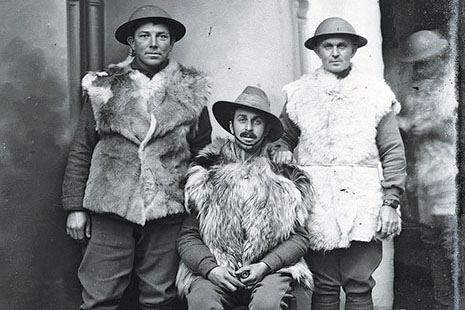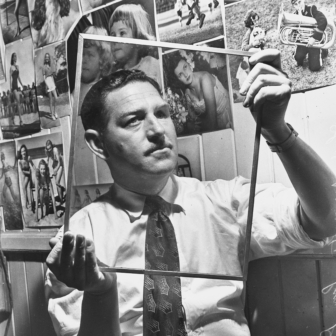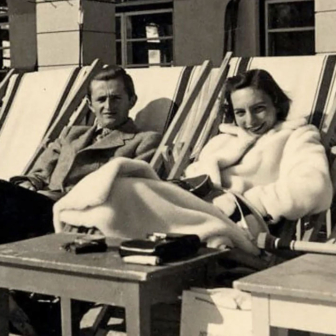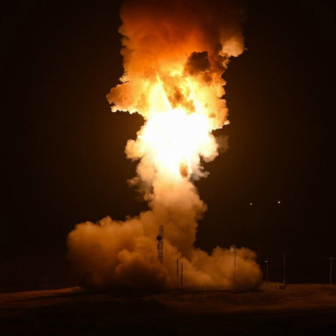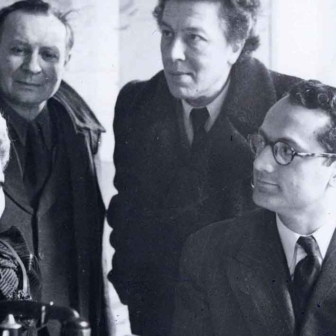Remember Me: The Lost Diggers of Vignacourt
Australian War Memorial Touring Exhibition
State Library of New South Wales until 18 January 2015
The Lost Diggers
By Ross Coulthart | HarperCollins | $70
What are we looking for when we look at old photographs, particularly photographs of people long dead? What is it that holds our attention for more than a moment, and brings us back again? Many powerful, iconic images do just that – bring us back again and again – but sometimes the power resides not so much in a single image as in an entire collection, the individual components commenting on and illuminating one another to create something greater than its parts.
Such is the case with the photographs that make up the exhibition Remember Me: The Lost Diggers of Vignacourt. The exhibition draws on a vast collection of glass-plate photographic negatives – as many as 4000 of them – taken during the first world war in the small village of Vignacourt in northern France by a young man called Louis Thuillier and his wife Antoinette. It was in Vignacourt that Allied troops, many of them Australian, were granted brief respites from the relentless fighting just a matter of kilometres away.
The story of how Channel Seven’s Sunday Night program discovered this treasure trove, which lay largely undisturbed and surprisingly undamaged for almost one hundred years, fits the traditional pattern of such quests for hidden treasure. The moment of revelation, when the chest (in this case, three of them) is opened and the jewels are found glittering inside, came only at the end of a long and arduous journey, full of disappointments, false leads and obstacles strewn along the way. Ross Coulthart tells the story in The Lost Diggers, a book that includes many of the photographs developed from the rediscovered plates, together with biographical information on some of the men whose images have been preserved, in such astonishing detail, by means of emulsion on glass.
As an experienced journalist, Coulthart is alive to the story’s inherent drama. It is a classic tale of loss and recovery, with resonances that go far beyond the photographs themselves to the lives and deaths of the people depicted in them. For the most part, it is soldiers we see, although civilians, including women and children from the village of Vignacourt, appear in some of the shots – as do, in an intriguing subset of perhaps half a dozen images, men dressed as women, actors from a visiting theatrical troupe.
Always implicit in the story Coulthart tells is the possibility that the photographic plates could have been lost forever – that their survival can be put down to a series of chances. Coulthart describes the moment when he and his colleagues opened the three chests that had been stored, as lost or forgotten treasure often is, in the attic, waiting to be discovered, long after the original owners had died or moved on. “We could hardly believe what we were seeing,” Coulthart recalls. “The battered boxes were filled with glass negative photographic plates, and for hours we held them up to the attic window light, revealing often perfectly preserved ghostly negative images… of Australian diggers, British Tommies, Indian Sikhs with massive turbans, and French, Canadian and American soldiers.”
Fittingly for a story about the recovery of lost photographs, this moment in February 2011 is itself captured on film. Coulthart – along with colleagues from Channel Seven, and with specialist help from Peter Burness, a historian from the Australian War Memorial, and other experts – had by this time been on the trail for two years, ever since his interest had been stimulated by an article in the London Independent describing the unearthing of another, if far smaller, cache of photographs from the first world war that included several images of Australian troops. The story of what Coulthart and his colleagues found and how they found it, told in a pair of documentaries screened on Sunday Night in 2011 and now relayed in The Lost Diggers, turned out, as such stories usually do, to involve far more than following a map and, in due course, finding the missing treasure.
For one thing, the treasure had already been found, some twenty-five years earlier, by an enthusiastic young Frenchman named Laurent Mirouze, a businessman, part-time journalist and history buff. Mirouze had tried by various means, including direct contact with the Australian embassy in Paris, to stimulate wider recognition of the significance of what he had come across. No one appeared particularly interested. “Laurent never heard back from anyone at the Australian embassy,” Coulthart records, registering, in an understated way, his surprise that such a potentially significant find could fail to attract even a nominal response. But perhaps it is not so surprising. A quarter of a century on, as the centenary of the outbreak of the first world war approaches, there is a new and ever-growing interest in the war and Australia’s part in it, together with a comparable growth in people’s interest both in family history and in revisiting the photographic past. Perhaps buried treasure is successfully unearthed only when the times are ready for it.
Recognising this mood of public readiness, Channel Seven made much of the discovery. In addition to the documentaries, it created what became and remains a popular Facebook page, on which the images were posted and comments – particularly comments that might help to identify some of the men in the photographs – were invited from the public. The response, records Coulthart, was overwhelming. Kerry Stokes, chair of the Seven Network, lent his personal support to the project, as a result of which “the entire Thuillier collection of around 4000 glass photographic plates was purchased from the living descendants of Louis and Antoinette Thuillier, the couple who had supplemented their farming income during the war by selling pictures to passing Allied soldiers.”
Stokes has given 840 of the plates – most of them directly related to the Australian involvement in the war – to the Australian War Memorial. Of these, almost all, with the exception of forty or so that are too silvered or otherwise damaged to produce discernible images, can be viewed on a large touchscreen mounted in the exhibition space, as well as online at the War Memorial’s website. Many more images can be seen on Sunday Night’s website, which links to the Lost Diggers Facebook page. But the heart of the display at the War Memorial – and what makes a visit so worthwhile – lies in the seventy-four prints taken from the plates, impeccably conserved, developed (using mainly traditional methods), framed and hung. Presented in this way, on fibre-based paper that contributes to the extraordinary level of clarity and sharpness of the images, the prints communicate with a directness that is difficult to replicate on the screen.
IT’s important to remember that the images we see, whether online or displayed on the walls of the War Memorial, are not the images as they were seen by the subjects of the photographs, or by the friends and family in Australia who received their copies in the post. The original prints were in the form of postcards, hastily and cheaply produced before being sent on their way, sometimes with a brief annotation, sometimes without. While the photographic plates have survived remarkably well, the postcards have not; a few of those that do survive, yellowed and faded, are included in the exhibition, serving to emphasise even further the remarkable quality of the newly printed versions.
The postcards were proof that the men pictured on them were alive and well, at least at the time of dispatch. In an article about the exhibition in the spring 2012 issue of Wartime, the Australian War Memorial magazine, curator Janda Gooding notes how soldiers also “collected and traded photographic postcards as mementoes of friendships, and perhaps of mates lost.” In later wars, the men would take these kinds of photographs themselves. (As it happens, the article preceding Gooding’s in Wartime gives an overview of the vast number of photographs, official and unofficial, taken during the Vietnam war. “There were a lot of cameras in Vietnam,” we are laconically informed in the article’s sub-heading.) In France during the first world war, however, Australian soldiers were specifically forbidden, on security grounds, from carrying their own cameras. For any enterprising young French photographer, it was a ready market.
Louis and Antoinette Thuillier fitted the bill; they were enterprising in the manner required, and Louis in particular knew enough about photography for the couple to set up a courtyard studio and supply their customers with photographic postcards. First, they photographed the French troops who were billeted in the town or passing through; later came Allied soldiers granted their brief reprieve from the front. At some point, the Thuilliers introduced an added touch of professionalism: a painted canvas backdrop that has, miraculously, survived along with the glass plates, and is now hanging among the printed photographs, an exhibit in itself. The canvas backdrop, which appears in so many of these images, shows a double set of arches, lending a classical and even vaguely ecclesiastical air. The combination of the classical backdrop and the startlingly modern faces of the soldiers pictured in front of it acts as a visual embodiment of how we have grown to understand the first world war as an overwhelmingly disastrous clash, not just between opposing sides, but between the forces of tradition and modernity.
Most strikingly of all, and unusually for the substantial sub-genre that is studio portrait photography, in many of the images we can see the canvas backdrop in its entirety, with the floor of the courtyard and the brick or stuccoed wall against which the backdrop has been pinned acting as a kind of additional border. In some images, we can even see a doorway to the right of the backdrop, echoing the archways on the canvas, and leading who knows where. (This effect, of a backdrop against a background, generally found its way from the plates to the postcards without being cropped out or otherwise disguised.)
For reasons that are hard to specify, the images in which we can plainly see the boundaries of the backcloth against the workaday background of the Thuilliers’ farmyard studio are among the most moving and effective of all. The canvas functions as a kind of frame within a frame or, in several of the images, as a curtain, its left edge curling inwards and on to itself as if the whole thing, in its classical serenity, is about to be pulled aside to reveal the chaos and the bloodshed that is going on behind.
In many cases, the subjects of the photographs, sometimes on horseback or perched on motorcycles, sometimes grouped together in fours or fives or in even larger numbers, extend well beyond the borders of the backdrop, as if poised to burst out of the picture itself. The men on motorcycles seem to be emerging from the archways behind them, caught by the camera in a momentary pause in their journey from the past to the future. In one arresting image (above) – of a trio of soldiers, one sitting and two standing, and each of them wearing the sheepskin vests that were issued to soldiers to combat the severe winter of 1916–17 – we can glimpse, to the right of the main subject and beyond the canvas backdrop, the blurred outline of another soldier, presumably waiting his turn to be photographed.
OCCASIONALLY, what seems to be an upturned chair or a jumble of furniture lurks in the near-darkness, ready perhaps to be brought on as a prop for the next photograph. Farm animals and small children – including in some instances the Thuilliers’ young son – are sometimes drafted in to complement the composition, lending an extra element of informality. As is the case with many, perhaps all, of the best photographs of people, we get a sense of life beyond the frame. Here, the effect is complicated by the knowledge that, for many of these young men, there was not much remaining of their lives to be lived outside the photograph.
The composition of the images suggests a mixture of the professional and the amateur, a concern for some level of artifice and artistic control coming up against pressure from customers and the commercial imperative to just get on with it. For the Thuilliers, the lines of people waiting their turn must have severely limited the thought they could give to each composition. Yet, by a happy chance, this combination of professionalism and pragmatism, the artisanal commitment to doing the best job possible while still meeting the realities of the production line, seems entirely appropriate for capturing something essential about the Australian soldiers they are engaged in photographing. Image after image has an energy and a life to it that are not characteristic of studio photography of the period, as though the formal constraints imposed – or half-imposed – by the Thuilliers were not quite enough to damp down the personalities of the individual subjects.
The small repertoire of formal and fairly conventional “art director” touches – a chair here, a jardinière there – does not dominate; the overall impact remains one of naturalness and immediacy. This must be partly because the photographs were taken quickly, without elaborate preparations or set-ups. And while the exposure times necessary to complete the capture of an image would not have been counted in the nanoseconds of today, neither would they have been significantly longer; not time enough anyway for the poses to freeze into woodenness and immobility. A large element of spontaneity remains, as well as a discernible quality of fellow feeling from within the double portraits and the group photographs.
We do not get the impression that the participants have been thrown together at the last minute, as a way of making the queue move faster. Instead we get the sense – confirmed in some of the surviving correspondence to families, in which friends already mentioned in earlier letters are identified from within the same group portrait – that they have chosen to be photographed together. This is so even when the composition looks especially contrived, as it does in a photo in which five Australian soldiers, complete with apparently unlit cigarettes as props, act as a semi-circular frame or border to a smartly uniformed if slightly uncomfortable-looking Frenchman seated in the middle. Even here, despite the contrivance, a powerful air of good humour and goodwill emanates from the entire group.
The solitary Frenchman in this photograph acts as a reminder that the Thuilliers’ clientele was much wider than the prints at the exhibition can fully show. As Coulthart points out, their subjects came from across the full range of Allied troops and support personnel (including, for example, members of the Chinese Labour Corps, recruited by the British to undertake manual work). Remember Me acknowledges this aspect of the Thuilliers’ work by including among the printed images a small but representative sampling of these more “international” group photographs, and others can be seen as reproductions in Coulthart’s book and online. Looking at them alongside the images of the Australians raises questions about the extent to which we see photographs on their own terms and the extent to which we bring our own histories and preconceptions to the experience.
When we look at the portraits of the Australians, do we detect – beyond the obvious differences in clothing and appearance that tell us (usually) that they are not British or French or Indian or Chinese – a distinctive Australianness of character and bearing, or are we imposing it? The answer is probably more of the latter than we would generally care to acknowledge; but for all that, there is definitely something there, both in the way the Australians relate to one another and in how they present themselves to the camera, professional and soldierly on the one hand and yet faintly humorous and even a touch self-mocking on the other. Sometimes the humour is quite overt, as in the picture of the man with a duck on his lap; this droll soldier is identified as Private Herbert Alexander Mouat, 6th Battalion, who was destined to die, on 28 September 1918, of wounds he incurred in action.
The kind of humour explicitly displayed by Private Mouat, or implied in many of the other photographs, is not always present, of course; in some cases, the horror of what has been experienced is just too dominant in the men’s expressions to allow room for anything else. But overall, the Australian photographs do have something that is uniquely characteristic, distinguishable from the immediate impact on the viewer of the other national groupings – the splendidly uniformed dignity of the Sikhs, for example, or the quiet reserve and stoicism conveyed by the pictures of Nepalese soldiers, or the elegance and élan of the French.
Portrait photography – or, more specifically, pictures of people whose identities have been lost, rather than of historical figures or celebrities – encourages speculation. Who was that person, where did he come from, where did she go? (Many of the comments on vintage photography websites ask these often unanswerable questions, or versions of them.) This is particularly true of a Thuillier photograph, where, as Coulthart puts it, “the sharpness and clarity” of the image, “as well as its informality and good humour… invites the viewer and draws you into the story behind the faces.”
Yet the answers, the details of the story, where they do come to hand, can be strangely unsatisfying, perhaps because they can explain only so much. Coulthart’s The Lost Diggers includes a deal of biographical information gleaned both before and after the posting of the images on Facebook, yet as important as this process of identification and elaboration is – important for adding further to the historical record, for giving the men their full due, and for providing their descendants with as much information as possible – the real and lasting impact lies with the images themselves and the way that, individually and together, they encourage us to imagine ourselves into past lives.
LOUIS and Antoinette Thuillier appear to have given up photography after the war. Their life stories are as elusive as those of most of the people whose photographs they took, and as likely to remain so. Coulthart reveals that Louis died in 1931; echoing the violence of the war, he committed suicide by shooting himself in the head. Unlike other famously “discovered” photographers, the Thuilliers are not likely to be raised to the pantheon of photographic genius; not in the manner, for instance, of Vivian Maier (1926–2009), documenter of Chicago street life over more than forty years, or the studio photographer known as Disfarmer (1884–1959), both of whose works were made known, and whose reputations were established, only after their deaths, and after their archives had come dangerously close to disappearing altogether into irretrievable obscurity.
But nor is the output of the Thuilliers of interest solely because of its subject matter. There is more to it than that. The Thuillier collection, created by chance and preserved by chance, is an example of what can result from a mutually supportive conjunction, in a particular place at a particular moment, of artist and subject, photographer and sitter. Louis and Antoinette Thuillier’s work suggests a combination of professional discipline and relaxed goodwill, both maintained under undoubted pressure. Their sensitivity to their subjects’ humanity emerges clearly from within the accepted conventions of a commercial photographer of the time, paralleling the same kinds of characteristics that coexisted within their subjects – that mixture of military professionalism and frank irreverence that so many observers of the Australian troops commented on at the time. Thanks to the Thuillier photographs, that mixture can still be seen, powerfully coexisting today. •
